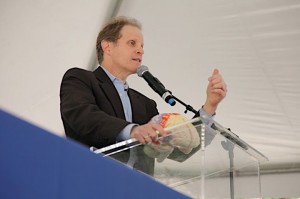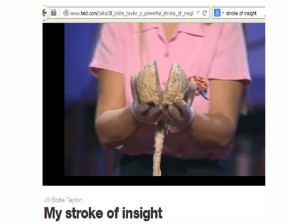 Dan Siegel’s webinar “How Mindfulness Can Change the Wiring of Our Brains,” which I found by accident in March 2011, insisted that we can re-wire our brains. Siegel actually used neuroplasticity and “mindsight” (see July 11 blog) to re-wire the brain of a ninety-two year old lawyer code-named “Stewart.” [FN1]
Dan Siegel’s webinar “How Mindfulness Can Change the Wiring of Our Brains,” which I found by accident in March 2011, insisted that we can re-wire our brains. Siegel actually used neuroplasticity and “mindsight” (see July 11 blog) to re-wire the brain of a ninety-two year old lawyer code-named “Stewart.” [FN1]
Stewart was an extreme case, but it’s how most of us live these days. We live in “head talk” in our frontal cortex, pretty much in dissociation from the emotions in our mammalian limbic brain. Stewart existed entirely in his thinking brain, but said he didn’t know what feelings were. He had almost no use of his emotional brain. “He’s a good example of a need for bilateral integration,” as Siegel put it.
Emotions? We think the objective is to get rid of ‘em, just “grow up” and be rational like Spock on Star Trek. “Too many Americans are spurred to achieve (business, academia, etc.) rather than to attach (to other human mammals), warn three top psychiatrists in the key book “A General Theory of Love.” We’ve been taught that our performance is our identity, so we over-perform, thinking non-stop. That leaves almost no hours for “face time” to simply “be” with and be present with live human beings.
Yet in fact emotions are sanity and mental health, not the reverse. And that’s not an endorsement of road rage. But we need secure attachment as kids, while our emotions first develop, to learn to govern (regulate) emotions by sharing them with our human mammal living group so we don’t go nuts. Yet sharing emotions is far out of style these days, and in the last census, “one third of American households were one person,” as Dr. Bruce Perry notes. Having no social option, we dissociate from our emotions.
Stewart began acting strangely when his wife of sixty five years took ill, so his son brought dad to see Siegel. “Stewart comes in and his son says that he thinks his dad might be depressed,” Siegel said. “Stewart was withdrawn and cantankerous, but the feeling I got wasn’t that he was sad or depressed, but that there was something just kind of vacuous and disconnected about him. When I got to talk to Stewart alone, he still didn’t seem depressed. He seemed more aloof than anything else.”
Stewart’s thinking brain was in great shape; “his cognition at ninety-two was totally intact—excellent memory for facts,” said Siegel, and his legal business was successful.
But when Siegel checked on Stewart’s emotions, the gent drew a complete blank.
Living with Half a Brain
 And Stewart drew the biggest blank when Siegel asked him about his emotions during childhood.
And Stewart drew the biggest blank when Siegel asked him about his emotions during childhood.
“I did a brief Adult Attachment Interview (AAI) assessment, which I do with most of my patients,” Siegel said. (See my all-new blog on the AAI here; finally got the story.) The AAI shows how emotionally close the adult interviewee got to their parents as a child.
But that just annoyed Stewart. “He thought it was absolutely a moot point that I was reviewing his relationship with his parents almost 90 years ago…
“ ‘You’re out of your mind’ Stewart said,” Siegel laughed. “He insisted that ‘relationships didn’t matter,’ his son said; ‘he’s always had that attitude.’ ” Stewart’s wife had more data. “She said that his parents, as Stewart had also factually stated, were ‘the coldest people on the planet.’ They lacked the ability to see the internal world. Everything was about managing Stewart’s behavior and his physical externals—his food, his shelter, his schooling — but nothing was focused on feelings or thoughts, or the meaning of things.”
Siegel pushed back, telling Stewart that they had to look into his childhood because “synaptic connections get formed early in life.” And then it came out that Stewart couldn’t remember much about his childhood experiences at all; he only remembered logical facts such as dates. This showed “a big difference between the left and right hemispheres of his brain,” said Siegel. Stewart could handle lots of facts with his left brain, but lacked recall of fleshed-out experiences, which are more an emotional phenomenon in the right brain.
Then Siegel gave Stewart the bottom line; he said that likely Stewart’s wife’s illness “had made him go more into withdrawal from relationships.” He also said that his tests of right and left hemisphere functioning showed that Stewart’s right brain “wasn’t very developed.”
“I said, ‘I don’t think you’re depressed. I think you’re living with half a brain.
“And… I just want to offer you the idea that you did the best you could in childhood, but the lack of focus on you internal world didn’t develop that part of your brain, so you’ve lived a life dominated by one side and not the other.”
The photo above shows the actual normal separation of the two halves of a human brain, connected only at bottom by the corpus callosum, displayed by Jill Bolte Taylor in “My Stroke of Insight” on Ted Talks in February 2008.
“And when I asked how it felt when I said that, he paused and said he didn’t know what that question meant. He said that for his whole life, people have asked him how he felt, and he had no idea what they were talking about,” Siegel went on.
“Then, he paused again and said, ‘Maybe before I die, I can learn what that question means.’
“So then we went on a journey together,” Siegel said, “and the idea is this: if a part of your brain is underdeveloped, not destroyed, but underdeveloped, it can be changed. And even if it’s destroyed maybe you can sometimes get around that, as in abuse. I want to make sure to say that. Neuroplasticity, as you’ll see in Stewart’s case, exists throughout the lifespan.”
Next Friday August 1: More current news and videos from Dan Siegel and his collaborators.
Next blog Friday August 8: Siegel and Stewart’s journey… not forgetting Jill Bolte Taylor.
——————
Kathy’s news blogs expand on her book “DON’T TRY THIS AT HOME: The Silent Epidemic of Attachment Disorder—How I accidentally regressed myself back to infancy and healed it all.” Watch for the continuing series each Friday, as she explores her journey of recovery by learning the hard way about Attachment Disorder in adults, adult Attachment Theory, and the Adult Attachment Interview.
Footnotes
For biography, website, books and more: see Footnotes at bottom of http://attachmentdisorderhealing.com/Daniel-Siegel-3/
FN1 Siegel, Daniel J., MD, “How Mindfulness Can Change the Wiring of Our Brains,” National Institute for the Clinical Application of Behavioral Medicine (NICABM), www.nicabm.com; 2010 Webcast and my first NICABM webinar, downloaded March 31, 2011. Rebroadcast October 11, 2011. http://www.nicabm.com/nicabmblog/meditation-medication/ and http://www.nicabm.com/mindfulness-2011-new/
![]()



Pingback: Dissociation Nation: Half a Brain | "Don't...